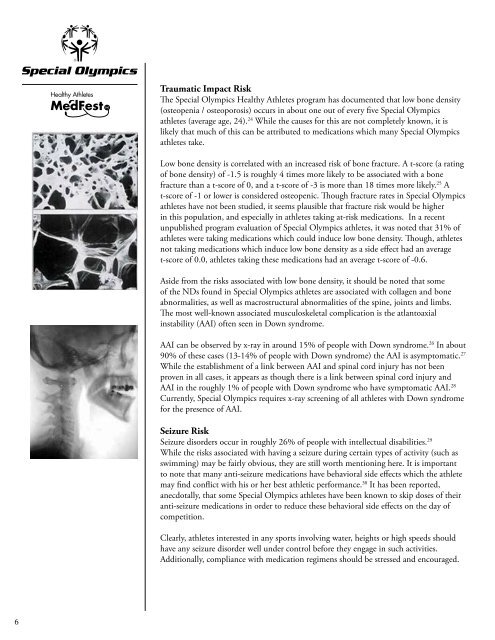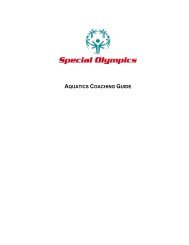MedFest Manual for Clinical Directors - Special Olympics
MedFest Manual for Clinical Directors - Special Olympics
MedFest Manual for Clinical Directors - Special Olympics
You also want an ePaper? Increase the reach of your titles
YUMPU automatically turns print PDFs into web optimized ePapers that Google loves.
6<br />
Traumatic Impact Risk<br />
The <strong>Special</strong> <strong>Olympics</strong> Healthy Athletes program has documented that low bone density<br />
(osteopenia / osteoporosis) occurs in about one out of every five <strong>Special</strong> <strong>Olympics</strong><br />
athletes (average age, 24). 24 While the causes <strong>for</strong> this are not completely known, it is<br />
likely that much of this can be attributed to medications which many <strong>Special</strong> <strong>Olympics</strong><br />
athletes take.<br />
Low bone density is correlated with an increased risk of bone fracture. A t-score (a rating<br />
of bone density) of -1.5 is roughly 4 times more likely to be associated with a bone<br />
fracture than a t-score of 0, and a t-score of -3 is more than 18 times more likely. 25 A<br />
t-score of -1 or lower is considered osteopenic. Though fracture rates in <strong>Special</strong> <strong>Olympics</strong><br />
athletes have not been studied, it seems plausible that fracture risk would be higher<br />
in this population, and especially in athletes taking at-risk medications. In a recent<br />
unpublished program evaluation of <strong>Special</strong> <strong>Olympics</strong> athletes, it was noted that 31% of<br />
athletes were taking medications which could induce low bone density. Though, athletes<br />
not taking medications which induce low bone density as a side effect had an average<br />
t-score of 0.0, athletes taking these medications had an average t-score of -0.6.<br />
Aside from the risks associated with low bone density, it should be noted that some<br />
of the NDs found in <strong>Special</strong> <strong>Olympics</strong> athletes are associated with collagen and bone<br />
abnormalities, as well as macrostructural abnormalities of the spine, joints and limbs.<br />
The most well-known associated musculoskeletal complication is the atlantoaxial<br />
instability (AAI) often seen in Down syndrome.<br />
AAI can be observed by x-ray in around 15% of people with Down syndrome. 26 In about<br />
90% of these cases (13-14% of people with Down syndrome) the AAI is asymptomatic. 27<br />
While the establishment of a link between AAI and spinal cord injury has not been<br />
proven in all cases, it appears as though there is a link between spinal cord injury and<br />
AAI in the roughly 1% of people with Down syndrome who have symptomatic AAI. 28<br />
Currently, <strong>Special</strong> <strong>Olympics</strong> requires x-ray screening of all athletes with Down syndrome<br />
<strong>for</strong> the presence of AAI.<br />
Seizure Risk<br />
Seizure disorders occur in roughly 26% of people with intellectual disabilities. 29<br />
While the risks associated with having a seizure during certain types of activity (such as<br />
swimming) may be fairly obvious, they are still worth mentioning here. It is important<br />
to note that many anti-seizure medications have behavioral side effects which the athlete<br />
may find conflict with his or her best athletic per<strong>for</strong>mance. 30 It has been reported,<br />
anecdotally, that some <strong>Special</strong> <strong>Olympics</strong> athletes have been known to skip doses of their<br />
anti-seizure medications in order to reduce these behavioral side effects on the day of<br />
competition.<br />
Clearly, athletes interested in any sports involving water, heights or high speeds should<br />
have any seizure disorder well under control be<strong>for</strong>e they engage in such activities.<br />
Additionally, compliance with medication regimens should be stressed and encouraged.

















